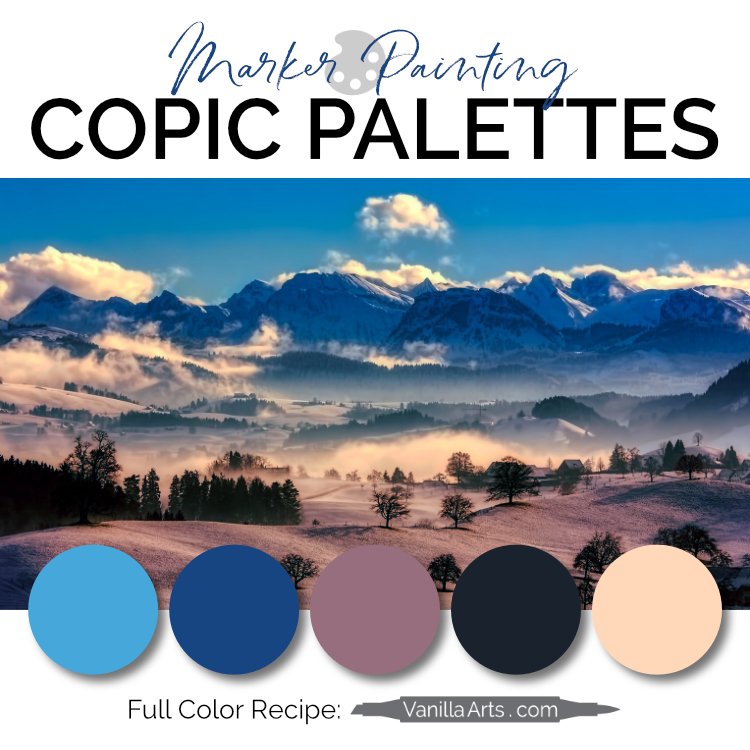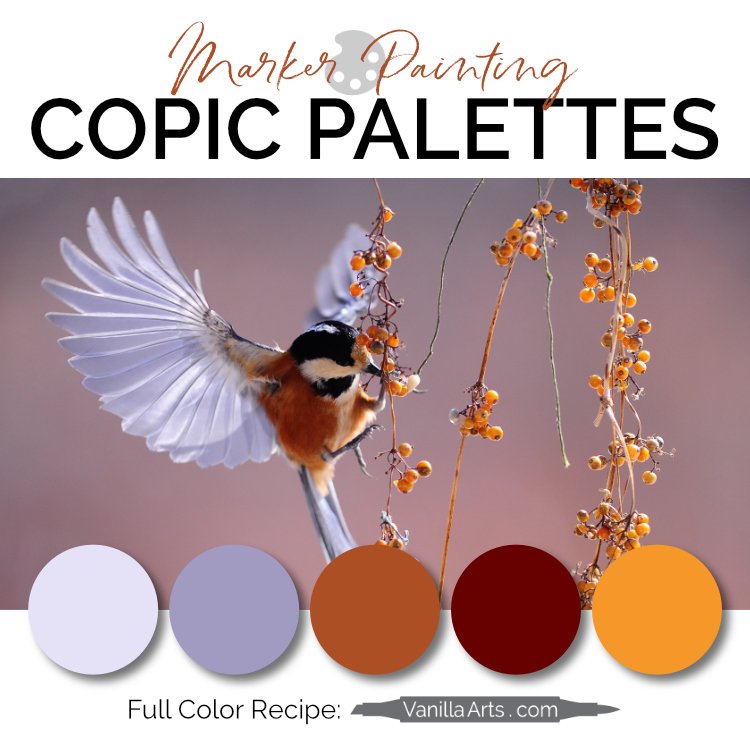Artistic Coloring: Loosen Up! (Copic Marker, Colored Pencil)
I color upside-down and backwards
Not kidding.
When I teach live classes, I demonstrate the entire project upside-down and backwards.
My students want to see what I'm doing. And because my classrooms are simple rooms and not high end instructional spaces, I don’t have the luxury of coloring at a fancy table with mirrors or a camera hovering overhead so that students can watch from afar.
Nope, we’re very low-tech. I tape my project to a small board and rest that board against my chest, project facing outwards. I walk around the room demonstrating and coloring, using my body as a desk.
I know it sounds strange but it works.
My project is upside down and backwards from my vantage point but it's right side up and easily visible to everyone else. Students can watch me color and see exactly what to do.
But here's the thing, my upside down and backwards projects don't look all that different from the ones I color at home sitting at my art table. Sometimes I can't tell which projects were colored which way.
I'm not telling you this to impress you with my amazing upside down coloring skills.
I'm telling you this because you need to loosen up.
Students can be very intense
They come to class to learn and they’re quite determined.
They want to mimic every little stroke I make. They copy my moves carefully. They analyze where my strokes start and where they stop; they count how many flicks it takes me to fill the space. Some even ask me to measure how long each flick is. They swoop when I swoop and dot precisely where I dot.
Students try to duplicate everything about my coloring.
Except in all my years of teaching, not one student has ever stood up.
Nobody puts their project on their chest and tries coloring upside down and backwards.
Which is strange.
They really think they're copying me exactly, move for move, and yet no one has noted that I'm doing it upside-down and backwards.
They’re all focused on what I’m doing without ever stopping to consider how I’m doing it.
And the how is more important, vastly more important than the number, the length, and the size of my strokes.
Remember when I said that I usually can’t tell whether I colored something in a demo or at home?
That’s because I color the same sitting down at a table as I do standing up.
I color from the elbow and shoulder
So it doesn’t matter where I am or what the furniture is like. You could hang me from a bungee cord over a pit of rabid sharks and I could still crank out a decent flick stroke because I color with my whole arm rather than my fingers.
Coloring from the elbow? Coloring from the fingers?
What does that mean?
Well, pull out a Copic and draw a small square. Now color that square in.
Go ahead and try it.
Right now, draw a 1 inch square and color it in. I’ll wait until you’re done.
Did you color the square? Good. Now think about what movements you used to fill in that square.
Which parts of your hand and arm were moving?
Need to color another square to find out? That’s okay. I’ll wait again.
Okay, so you colored both squares.
Now I’m going to make a few educated guesses about what was going on. Ready?
You sat down at a table- because sitting stabilizes your body and the table stabilizes your arm.
You pressed the entire length of your forearm (from elbow to wrist) directly to the table, adding even more stabilization.
You lifted your wrist but that was really only to elevate the marker over the square. Aside from that hovering, you locked your wrist.
For those of you who didn’t hover, you rested the entire pinkie side of your hand against the paper- and if you didn’t lock your wrist, you made every effort to keep it still and stable.
All of the coloring motion came from the movement in your knuckles- primarily your thumb, index, and middle fingers.
And all of that stabilization and support is why you make teeny tiny, up-tight, constipated looking projects.
You need to loosen up!
You've got to move your body when you color. You should be having fun dancing with your markers.
Look, it’s not your fault. You’re doing exactly what your kindergarten teacher told you to do when she taught you how to make your A, B, Cs. Printing and penmanship are finger actions. You work from the knuckle and that gives you the ability to make tiny yet precise movements.
But that isn’t how to paint.
I know, you’re coloring with a Copic Marker but that marker has a brush nib on it.
Brush nib.
A brush.
This indicates that the proper use of this tool is to treat your Copic like a paintbrush.
Painters don’t choke up to the tip of their paintbrushes. They don’t crab up on their canvas and work with their nose hovering two inches away from the painting.
And I see colorers do this all the time. You curl up around your coloring project like a boa constrictor, making teeny tiny movements that are tight and micromanaged. You white-knuckle the marker with a death grip. You give yourself carpal tunnel syndrome and pins & needles circulation problems.
And that tension? Whoa! It definitely shows in your coloring.
Constipated coloring is a real turn-off.
Lighten up and loosen up. For your health and for your art.
It’s not good to grip your marker as if you just fell off the Titanic- as if that marker is the only thing keeping Celine Dion from writing a song about your death.
Uptight coloring hurts your hand
It also kills your project.
Good flicks are light and swishy. It’s like licking an ice cream cone- you don’t do it with all the force you can muster. There’s a delicacy to keeping everything from going splat on the sidewalk.
A good series of flicks is carefree and a little loosey goosey.
And that motion has to be generated from the largest pivot point on your arm that you can give it.
The smaller the joint you use, the more cramped and stunted your flicks will be.
Finger flicks are stubby.
If the movement of your flick comes from the wrist, that’s an improvement over your fingers. But it’ll be even better if you can move from the elbow or the shoulder. There should even be a little waist and spine twist action involved.
After a long coloring session, pay attention to what hurts. If your fingers are sore, that’s a bad sign. If you feel it in your triceps and biceps, that’s great!
I use the metaphor of dancing a lot, and it’s on purpose. Nobody stands out on the dance floor, moving just their index fingers. Gettin' down and grooving is a whole body event. Coloring should be too.
Now I’m not going to lie to you. It takes practice to color from the elbow with control but the effort is worth it. You’ll notice an improvement in the length and lightness of your flicks and improved blending powers, but also in the expressive nature of your coloring.
Expressive is good. That's the artsy stuff that makes you look like a pro.
It’s a mistake to curl your entire body inward when you color.
Most colorers concentrate too much
Concentrate, it’s right there in the word. Concentration isn’t just thinking super-duper hard, concentration is also the word we use to describe a reduction.
When you reduce your motion and microfocus everything into your fingers, you hamper your artistry.
Where is your heart located?
Your heart is inside your chest, in the core of your body.
When you are tightened-up and coloring with just your fingers, you are not coloring from the core.
You can’t add heart to a finger project.
Step back so that you can see your work. Move away from the table slightly so that you can freely swing your arm. Loosen up, bend and sway so that you can extend the length of your flicks and add some character to your strokes.
And relax. Because perfect blends and precise color placement do not make the art.
Artistry comes from your core. Use your heart and you’ll make better art.
Want to add more artistry to your coloring?
Read more Adding Artistry articles:
Artistic Coloring- Adding Creativity to Your Copic Projects: Your Brain Lies!














